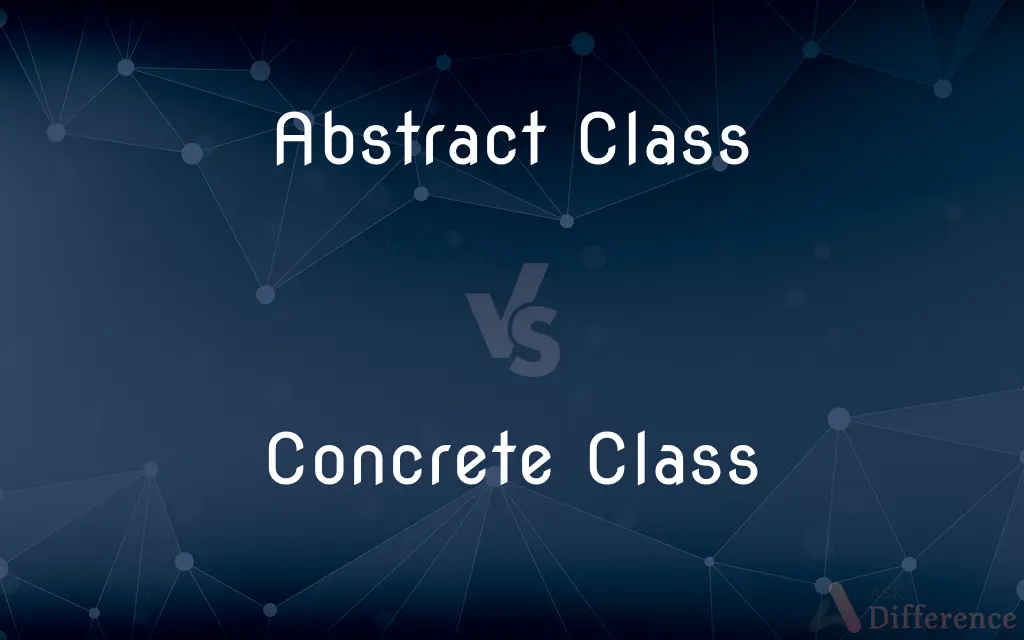Abstract Class vs. Concrete Class — What's the Difference?
By Tayyaba Rehman — Published on December 8, 2023
Abstract Class is a blueprint for other classes, can't be instantiated. Concrete Class is a standard class, instantiated into objects. Both form OOP hierarchy.

Difference Between Abstract Class and Concrete Class
Table of Contents
ADVERTISEMENT
Key Differences
An Abstract Class, within the realm of object-oriented programming (OOP), acts as a blueprint for other classes, with the distinctive characteristic of not being instantiable. In contrast, a Concrete Class refers to standard classes in OOP that can be instantiated, meaning you can create objects from them directly.
Abstract Classes are foundational structures that allow developers to create a class which defines an idealized interface but doesn’t provide a complete implementation for all its methods. On the other hand, every method in a Concrete Class has its body fully defined and functional, ready for direct object creation and usage.
When using an Abstract Class, one must inherit its properties in a derived class, providing implementations for abstract methods. With a Concrete Class, there’s no obligation to override or implement any methods, as they are designed to be instantiated as they are.
The purpose of an Abstract Class is to provide an appropriate base class from which other classes can inherit, to reuse the code. A Concrete Class, however, is used to define objects that will be directly instantiated and manipulated in a program.
In an Abstract Class, you can declare both abstract methods, which have no implementation, and concrete methods, which have an implementation. Conversely, in a Concrete Class, all methods must be fully implemented, ready for an object's instant usage in the software.
ADVERTISEMENT
Comparison Chart
Instantiation
Cannot be instantiated
Can be instantiated
Method Implementation
May have unimplemented methods
All methods fully implemented
Usage
Blueprint for other classes
Used for creating objects
Inheritance
Must be extended/inherited
No need for extension
Method Types
Can have both abstract and concrete methods
Only concrete methods
Compare with Definitions
Abstract Class
Can't be instantiated directly.
You can't create an object of an Abstract Class; it's a template for other classes.
Concrete Class
Can be instantiated.
We created several objects from the Concrete Class for direct application in the program.
Abstract Class
Used for inheritance purposes.
We designed an Abstract Class to provide a common base for all related classes.
Concrete Class
Doesn't need to be extended.
The Concrete Class was complete and didn’t require any inheritance for functionality.
Abstract Class
May contain abstract methods.
The Abstract Class contained methods that were left for the subclass to define.
Concrete Class
Ready for direct usage.
We utilized multiple instances of the Concrete Class in various parts of our software.
Abstract Class
Allows code reuse and extension.
By creating an Abstract Class, we could ensure consistent method calls across subclasses.
Concrete Class
Represents real-world objects.
Each object instantiated from the Concrete Class had properties like color and size.
Abstract Class
Can contain default behavior.
Our Abstract Class includes several fully defined methods usable by any subclass.
Concrete Class
Has all methods defined.
The Concrete Class was immediately usable thanks to its fully implemented methods.
Common Curiosities
What characterizes a Concrete Class?
A Concrete Class is a standard class in OOP that can be instantiated and used directly.
Do all methods in a Concrete Class have implementations?
Yes, all methods in a Concrete Class are fully implemented.
What is an Abstract Class?
An Abstract Class is a class that cannot be instantiated and is designed to be subclassed.
Can Abstract Classes have normal methods?
Yes, they can have both abstract methods (no body) and concrete methods (with a body).
Can I create an object of an Abstract Class?
No, objects cannot be created from an Abstract Class directly.
Do Abstract Classes contain unimplemented methods?
Yes, Abstract Classes can have abstract methods without implementations.
How does a Concrete Class differ from an Abstract Class?
Concrete Classes are instantiable with fully defined methods, unlike Abstract Classes.
Why use an Abstract Class?
Abstract Classes provide a blueprint for common functionality in subclasses.
Are objects of Concrete Classes directly usable?
Yes, objects of Concrete Classes are instantiated for direct use in programs.
What kind of methods does a Concrete Class have?
A Concrete Class contains only fully implemented, or "concrete," methods.
Can a Concrete Class be inherited?
Yes, but unlike Abstract Classes, they don't require extension to be useful.
Is it mandatory to override methods in a Concrete Class?
No, methods in a Concrete Class are ready to use as they are.
What's the role of an Abstract Class in software development?
Abstract Classes allow for code reusability and enforce consistent interfaces in subclasses.
Can an Abstract Class contain a complete method?
Yes, Abstract Classes can have fully implemented, or "concrete," methods.
Why can't you instantiate an Abstract Class?
Abstract Classes are incomplete with abstract methods and are meant as blueprints for other classes.
Share Your Discovery

Previous Comparison
GAAP vs. 704 B
Next Comparison
HashMap vs. HashSetAuthor Spotlight
Written by
Tayyaba RehmanTayyaba Rehman is a distinguished writer, currently serving as a primary contributor to askdifference.com. As a researcher in semantics and etymology, Tayyaba's passion for the complexity of languages and their distinctions has found a perfect home on the platform. Tayyaba delves into the intricacies of language, distinguishing between commonly confused words and phrases, thereby providing clarity for readers worldwide.














































